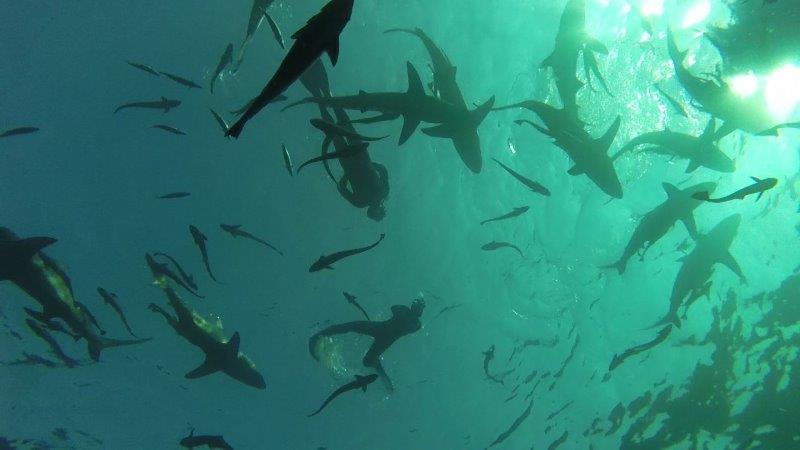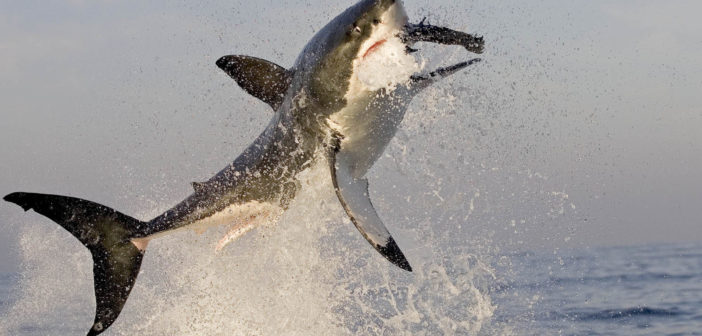Are South Africans warming to sharks? Roving Reporter, Natalie dos Santos, brings some heartening news from our chilly winter seas, even as fears grow for the future of these apex predators.
First published by Daily Maverick
It is an exciting time of year in South Africa’s seas. Upwellings of cold, nutrient- and plankton-rich waters off the West Coast in winter spark the annual sardine run. Huge oil slick shoals of sardines (Sardinops sagax) travel along the coast. And trailing them are frenzied predators such as common dolphins, gannets, cormorants and sharks.
For freedivers like me it’s a chance to jump into the water, to view what David Attenborough described on television as “The Greatest Shoal on Earth”.
Gannets turn into missiles as they dive into the water and the silver, boiling shoal morphs into tunnels as sharks charge through them at full speed.

As the shoals are pushed into shallow waters by spinner (Carcharhinus brevipinna), dusky (Carcharhinus obscurus), blacktip (Carcharhinus limbatus) and bronze whaler (Carcharhinus brachyurus) sharks, huge seine nets are dropped around them, dragging hundreds of sardines onto the beach where they are scooped into the crates.
“It has been interesting how many spinners and blacktips have been with the sardines this year,” said Dr Ryan Daly, top marine predator researcher at the Oceanographic Research Institute.
Daly said this year’s sardine run has been one of the largest and most consistent on record.
WATCH: Spinner shark charges through a shoal of sardines off Umdoni. Filmed by Andy Coetzee
https://www.instagram.com/p/CBn8UweJO9h/?igshid=1osjzb1thhliw

Out with the knife
Unfortunately, the sharks that chase the sardines often end up in the seine nets too. Here it can end badly for them.
Andy Coetzee, a nature conservationist and avid freediver, reckons fishermen frequently reach for their knives. And once they have the shark out the net or off the end of their lines, cut out its cartilaginous jaws. Dried and mounted, these jaws end up hung on walls as trophies. The rest of the carcass is left on the beach.
Because sharks are often associated with fear and attacks, crowds can be delighted when these incredibly important animals are caught and killed.
Estimates vary on the number of sharks killed globally every year, with figures ranging from 100 million to 273 million. Researchers believe the shark fin trade is a major contributor to the slaughter.
In False Bay, in the Wesern Cape, an unprecedented complete absence of white shark sightings has been noted, according to Dylan Irion, project leader of what has been dubbed “The great South African white shark count”.
This has raised fears of a local extinction. But as Irion explained, much painstaking work, bringing together photo-ID datasets and information collected from acoustic receivers, must be done. Only then can scientists come up with reliable numbers.


Good news
Meanwhile, there is good news to share from elsewhere in the country.
The public’s response to entangled sharks during this year’s sardine run has been amazing.
At the start of the sardine run, a shark release in Ramsgate, filmed by Faeez Mamdoo, made local news. After the shark is pulled out of the seine net by fishermen and bystanders, it rolls around in the shorebreak while members of the crowd scream in fear. But when it swims away freely, the whole crowd cheers in celebration.
About two weeks later, on Monday 15 June, a female bull shark (Carcharhinus leucas) was caught in a seine net at Rocky Bay.
Gareth Liesegang of Amith’s seine netting crew immediately cut the net to free the shark. The rest of the crew and bystanders then worked together to pull the shark out of the net and return her to the ocean.
“It was amazing to see everybody getting involved and cheering as the shark was set free,” said Jessica Escobar-Porras, a shark scientist based at the Aliwal Shoal Marine Protected Area. “It is a great change in people’s and netter’s attitude towards sharks.”

Their house
Just a few days after releasing the bull shark at Rocky Bay, Coetzee filmed another shark being rescued from a seine net at Pennington beach by fishermen, Keagan Murgatroyd and Arrin Walton.
According to Walton, the fisherman seen hauling the shark out the net by its tail in the video, three sharks were caught that eventful morning. Walton managed to release two by lifting the wing of the net. But one shark was trapped in the centre of the net, where sardines are channelled.
On the shore, Walton immediately alerted Murgatroyd and freeing the shark became their priority.
“Leaving the shark on the beach didn’t even cross our minds,” said Walton. “When we are in the water, we are in their house. I wouldn’t want anyone coming into my house and throwing me out, and I’m pretty sure the shark wouldn’t either.”
Walton has spent much of his life in the ocean surfing, diving and fishing with sharks and has never felt threatened by them.
“It has been fantastic to see the change of attitude and behaviour of the public towards sharks,” said Coetzee, who filmed the release.
Having previously witnessed netted sharks killed and left on the beach, Coetzee was grateful the public was now helping to return the sharks safely to the water.

Changing narratives
On 23 June, 14-year-old Zachary Berman captured drone footage of a safe encounter between a white (Carcharodon carcharias) shark (as great whites are also known) and paddlers in Plettenberg Bay. In the video, the naturally curious shark investigates the surfers and kayaker, who quickly but calmly exit the water when they notice the shark.
Caitlin Judge was one of the surfers in the water that day. In a Facebook post that went viral, Judge shared her thoughts on the way the media reported the interaction.
“He (the shark) cruised on past me, very relaxed. This isn’t abnormal here. Plett is a great white hotspot,” Judge said.
According to the National Sea Rescue Institute (NSRI), a surge in shark activity on the West Coast is normal at this time of year when sharks target seals and fish close to the shore.
“However, the media depictions of this interaction paint a different picture,” said Judge.
It was not long before Berman’s drone footage went viral and numerous articles reported “Terrifying drone footage” of the white shark that was “perilously close” to surfers.
Judge was disappointed that this was still the main narrative for the species. “This could have been a great opportunity to show a very calm interaction, which is much more the norm than any attack,” said Judge.

Time for change
The Facebook post was shared nearly 500 times, with many people agreeing the narrative must indeed change.
Berman, 14, who filmed the encounter, urged surfers and swimmers to be careful. But he also pointed out that the footage showed the calmness and beauty of these incredible animals.
Less than 24 hours after capturing the shark encounter, Berman returned to the same location and captured yet another safe encounter between sharks and surfers.
Project leader of Cape Town’s Shark Spotters Programme, Sarah Waries, told the NSRI, “It is important for people to remember that white sharks are naturally inquisitive apex predators and that although shark bites are rare, water users must understand the inherent risk associated with sharing the ocean with these animals and change their behaviour accordingly to avoid encountering sharks.”

Shark attack
While many still fear sharks, it is wonderful to see how this is changing in South Africans and all over the world. This new perception is thanks to campaigns like Shark Attack, which sheds light on misconceptions and raises awareness of the importance of sharks and why we need to protect them.
The campaign celebrated Shark Awareness Day on 14 July, sharing that South Africa was one of the top three global hotspots for shark and ray diversity. It is home to 204 different species, of which 69 are endemic to the country.
We should be proud of this. We are privileged to find sharks in our waters, where they keep our ocean ecosystems healthy and balanced. In so doing they ensure the ocean has enough food and oxygen to provide for us. It means we can go to it again and again, for our livelihoods and wellbeing.
During this year’s sardine run, nothing has made me prouder than witnessing fellow South Africans protecting our sharks. I hope we continue to do our bit by keeping sharks in the ocean where they belong and standing up for them when a tired old story needs to be changed.



- Marine biologist Natalie dos Santos is part of the WILDOCEANS Ocean Stewards programme. She is currently researching loggerhead turtles through the University of KwaZulu-Natal. She is also undergoing training as an Ocean Watch correspondent for Roving Reporters.
How the Daily Maverick covered the story: Jaws of life: Saving our amazing sharks
Now read… Wild waters, but where are all the sharks?
Also read… Starlight express: night adventures among the turtles of Bhanga Nek by Natalie dos Santos












